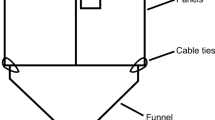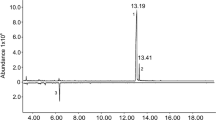Abstract
We report the identification, synthesis, and field bioassays of a volatile, male-produced aggregation pheromone of a long-horned beetle, the banded alder borer, Rosalia funebris Mots. Headspace collections from males contained a major male-specific compound, (Z)-3-decenyl (E)-2-hexenoate, and several minor components, identified as (Z)-3-decenol, (Z)-3-nonenyl (E)-2-hexenoate, and (Z)-3-decenyl (E)-3-hexenoate. The antennae of both males and females responded strongly to (Z)-3-decenyl (E)-2-hexenoate. We collected significant numbers of adult R. funebris in field bioassays using traps baited with this compound. This pheromone structure is unprecedented in the literature of cerambycid pheromones and distinct from the more common diol/hydroxyketone pheromone motif of many other species of the diverse subfamily Cerambycinae. This is the first pheromone identified for a species in the tribe Rosaliini.


Similar content being viewed by others
References
Barbour, J. D., Cervantes, D. E., Lacey, E. S., and Hanks, L. M. 2006. Calling behavior in the primitive longhorned beetle Prionus californicus Mots. J. Insect Behav 19:623–629.
Brown, C. A., and Ahuja, V. K. 1973. “P-2 nickel” catalyst with ethylenediamine, a novel system for highly stereospecific reduction of alkynes to cis-olefins. J. Chem. Soc. Chem. Commun. 1973:553–554.
Cervantes, D. E., Hanks, L. M., Lacey, E. S., and Barbour, J. D. 2006. First documentation of a volatile sex pheromone in a longhorned beetle (Coleoptera: Cerambycidae) of the primitive subfamily Prioninae. Ann. Entomol. Soc. Am 99:718–722.
Chemsak, J. A., and Linsley, E. G. 1971. Some aspects of adult assembly and sexual behavior of Rosalia funebris Motschulsky under artificial conditions. Pan-Pac Entomol 47:149–154.
Essig, E. O. 1943. The California-laurel borer, Rosalia funebris Mots. (Coleoptera: Cerambycidae). Pan-Pac. Entomol 19:91–92.
Ginzel, M. D., and Hanks, L. M. 2003. Contact pheromones as mate recognition cues of four species of longhorned beetles (Coleoptera: Cerambycidae). J. Insect Behav 16:181–187.
Ginzel, M. D., and Hanks, L. M. 2005. Role of host plant volatiles in mate location for three species of longhorned beetles. J. Chem. Ecol 31:213–217.
Ginzel, M. D., Blomquist, G. J., Millar, J. G., and Hanks, L. M. 2003a. The role of contact pheromones in mate location and recognition in Xylotrechus colonus. J. Chem. Ecol 29:533–545.
Ginzel, M. D., Millar, J. G., and Hanks, L. M. 2003b. (Z)-9-Pentacosene—contact sex pheromone of the locust borer, Megacyllene robiniae. Chemoecol 13:135–141.
Hanks, L. M. 1999. Influence of the larval host plant on reproductive strategies of cerambycid beetles. Annu. Rev. Entomol 44:483–505.
Hanks, L. M., Millar, J. G., Moreira, J. A., Barbour, J. D., Lacey, E. S., McElfresh, J. S., Reuter, F. R., and Ray, A. M. 2007. Using generic pheromone lures to expedite identification of aggregation pheromones for the cerambycid beetles Xylotrechus nauticus, Phymatodes lecontei, and Neoclytus modestus modestus. J. Chem. Ecol 33:889–907.
Hasner, A., and Alexanian, V. 1978. Synthetic methods. 12. Direct room temperature esterification of carboxylic acids. Tetrahedron Lett 46:4475–4478.
Hogge, L. R., and Millar, J. G. 1987. Characterization of unsaturated aliphatic compounds by GC/Mass spectrometry. Chapter 8, pp. 299–351, in J. C. Giddings, E. Grushka, and P. R. Brown (eds.). Advances in chromatography, vol. 27Dekker, New York.
Lacey, E. S., Ginzel, M. D., Millar, J. G., and Hanks, L. M. 2008a. 7-Methylheptacosane is a major component of the contact sex pheromone of the cerambycid beetle Neoclytus acuminatus acuminatus. Physiol. Entomol 33:209–216.
Lacey, E. S., Moreira, J. A., Millar, J. G., and Hanks, L. M. 2008b. A male-produced aggregation pheromone blend consisting of alkanediols, terpenoids, and an aromatic alcohol from the cerambycid beetle Megacyllene caryae. J. Chem. Ecol 34:408–417.
Linsley, E. G. 1964. The Cerambycidae of North America: Part V. Taxonomy and classification of the subfamily Cerambycinae, tribes Callichromini through Ancylocerini. Univ. Calif. Publ. Entomol 22:4–6.
Linsley, E. G. 1995. The banded alder beetle in natural and urban environments (Coleoptera: Cerambycidae). Pan-Pac Entomol 71:133–134.
McElfresh, J. S., and Millar, J. G. 1999. Sex attractant pheromone of the saturniid moth Coloradia velda. J. Chem. Ecol 25:1067–1078.
Monné, M. A., and Hovore, F. T. 2005. Checklist of the Cerambycidae (Coleoptera) of the Western Hemisphere. BioQuip, Rancho Dominguez, CA.
Ray, A. M., Lacey, E. S., and Hanks, L. M. 2006. Predicted taxonomic patterns in pheromone production by longhorned beetles. Naturwissenschaften 93:543–550.
Sas Institute 2001. SAS/STAT user's guide for personal computers, release 8.01. SAS Institute, Cary, NC.
Sokal, R. R., and Rohlf, F. J. 1995. Biometry, 3rd edn. Freeman, New York, NY.
Acknowledgments
We thank Dianne Erskine-Hellrigel, Agustin Hernandez, Chris Sapovchak, and Ian Wright for assistance with laboratory and field work and Michael Long and the Los Angeles County Department of Parks and Recreation for permission to conduct research in Placerita Canyon Natural Area. This project was supported by a Francis M. and Harlie M. Clark Research Support Grant (UIUC, to AMR), the Alphawood Foundation (to LMH), and the National Research Initiative of the USDA Cooperative State Research, Education and Extension Service, grant number #2006-35302-17457 (to JGM and LMH). This research was in partial fulfillment of a Ph.D. degree for AMR from UIUC.
Author information
Authors and Affiliations
Corresponding authors
Electronic supplementary material
Below is the link to the electronic supplementary material.
ESM 1
(DOC 1.76 MB).
Rights and permissions
About this article
Cite this article
Ray, A.M., Millar, J.G., McElfresh, J.S. et al. Male-Produced Aggregation Pheromone of the Cerambycid Beetle Rosalia funebris . J Chem Ecol 35, 96–103 (2009). https://doi.org/10.1007/s10886-008-9576-2
Received:
Revised:
Accepted:
Published:
Issue Date:
DOI: https://doi.org/10.1007/s10886-008-9576-2




